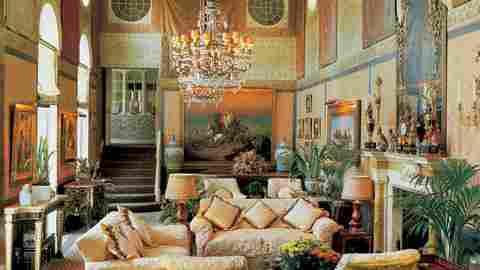July 08,2022
Renzo Mongiardino
by David Stewart
View Slideshow

Though he was often referred to as the greatest designer of the twentieth century, Renzo Mongiardino was never a household name—not even in his native Italy, where he lived and worked until his death in 1998 at the age of eighty-one. Instead, he was that most rarefied of talents: a designer's designer, a creator of dazzling special effects that were built on a foundation of exacting scholarship.
Atmosphere, not authenticity, was the secret of his success; after all, he was, first and foremost, a set designer. Who can forget the Renaissance earthiness of the sets for the rough-and-tumble Zeffirelli film The Taming of the Shrew ? His décors were similarly dramatic. Whether executed for a French aristocrat like Baron Guy de Rothschild, a Manhattan financier like Peter Sharp or an international presence like Gianni Versace, a house by Renzo Mongiardino was a miracle of stage-set trickery. Floors were paved in marble that was not marble; walls were paneled with Neoclassical boiseries that had been conjured out of paint and shadows; sofas and chairs were upholstered in sumptuous velvets skillfully aged by an artisan who then scribbled on them with colored pens from an office-supply store.
"Illusion comes into being as part of the pleasure," he wrote in Roomscapes, a treatise on his specialty, which he preferred to call "decorative architecture." The same painters, carpenters, gilders and model makers who manufactured Mongiardino's sets for stage and screen worked on the maestro's interiors as well (including Lila de Nobili, a painter and designer whose work in the Italian theater world was every bit as revered as his own).
Stainless-steel modernism held no allure for the extravagantly bearded designer, who was born in 1916 and raised in a Baroque palazzo in Genoa. Its romantic shadows and sparkling chandeliers were the spirit behind the Proustian nostalgia of his work. However, though he was fond of quoting a maxim of Honoré de Balzac's—"The wise man goes back to the origins of ancient times"—Mongiardino was a twentieth-century talent and therefore more than willing to harness up-to-date materials in his quest to resuscitate the past. It was a contradiction neatly mirrored in the designer's ancestry: His father was a self-made millionaire who had introduced color television to Italy, while his mother was from a venerable Genoese family.
Plywood could be exactingly painted to mimic multitudinous effects: Moroccan tilework, Renaissance intarsia, Turkish carpets. Cardboard was pressed, painted and gilded in the manner of tooled cordovan leather. And more often than not, a room's monumental architectural features—cornices, capitals, chimneypieces—turned out to be exquisitely molded plastic. Certainly none of this sleight of hand was inexpensive. One can only imagine what it must have cost to dress a room with colorful Sicilian scarves, lacquered and then delicately enriched with floral overpainting, as the designer did in the 1960s for Stanislas and Lee Radziwill's house in Oxfordshire, England.
Wherever Renzo Mongiardino's commissions took him, he always succeeded in creating brand-new rooms that were nevertheless imbued with the wonders of the past. His aesthetic suggested a more theatrical, highly emotional cousin of the "humble elegance" espoused by his English contemporary John Fowler. Steeped in history and romance, his interiors never failed to evoke what one admirer called "the corrosive breath of the breeze of melancholy."






